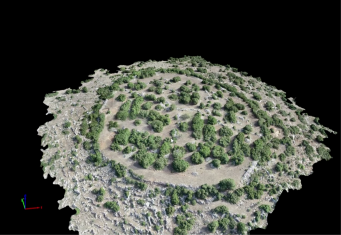The Sites
Situated near the ancient Greek sanctuary site of Delphi and overlooking the Corinthian Gulf south of Mount Parnassos, the ancient citadels of Antikyra-Steno and Desfina-Kastrouli sit at the border of the ancient regions of Boeotia and Phokis. We are told by Homer (Il. 2.494-759, cf. Koh et al. 2020) that Phokis sent forty ships to fight with the Achaeans at Troy, alluding to a thriving region during the international Late Bronze Age. Preliminary work carried out in 2016 and 2017 – which included survey and mapping along with targeted excavations – revealed a site fortified with “Cyclopean” masonry typical of the Late Helladic III period with the promise of large structures within. Rock-cut chamber tombs with multiple burials – containing fine perfumed oil stirrup jars, gold foil ornaments, figurines, and bronze – were in use from Late Helladic IIIA2 to Late Helladic IIIC Early, ca. 1350-1150 B.C.E. (Liritzis et al. 2016, Sideris et al. 2017, Chovalopoulou et al. 2017, Levy et al. 2018).
In 2018, new excavations in the Southern Terrace of Kastrouli revealed three layers of ancient occupation in two buildings that showed this area of the site was continuously occupied from at least LH IIIB2 during the apparent peak occupation of the site until it was destroyed, probably by earthquake, in LH IIIC Middle, ca. 1100 B.C.E. This is several generations after the Kastrouli tombs excavated thus far fell out of use and a century after the widespread destructions at palatial sites across Greece, ca. 1200 B.C.E., hinting at cultural continuity in Southern Phokis despite the Bronze Age collapse (Koh et al. 2020, cf. Koh and Birney 2017). The larger Building 2 East produced a clay fragment with what appears to be the Linear B logogram for cloth, which fits with the pastoral history of the region. When taken into consideration with the regional topography, rich burial goods, and extensive infrastructure with Cyclopean masonry, Kastrouli makes the best case to be the Homeric site of Anemoreia with the nearby harbor site of Antikyra-Steno likely Kyparissos if we trust the ethnographic account of Pausanias (10.36.5, cf. Koh et al. 2020.). The Southern Terrace buildings were refurbished shortly after their destruction in LH IIIC Middle until falling out of use several generations later in LH IIIC Late (ca. 1050 B.C.E.) or even Submycenaean/Protogeometric (ca. 1000 B.C.E.). There are hints of intrusive burials in the outermost terrace suggesting the continued use of the site into the 1st millennium B.C.E. if at a reduced scale, which holds great promise in helping us better understand both the post-palatial Mediterranean world after the Bronze Age collapse and the rise of Classical Greece.
Under the auspices of the Hellenic Ministry of Culture and the Yale Peabody Museum of Natural History, Dr. Andrew Koh (Yale/MIT), Dr. Ioannis Liritzis (University of the Aegean), Dr. Yiota Manti (Ionian University), Dr. Cheryl Floyd, Dr. Trevor Luke (Florida State), and Ian Roy (Brandeis) are continuing to explore the ancient citadels at Desfina-Kastrouli and Antikyra-Steno along with their greater environs within the longue durée context of the Southern Phokis Regional Project. Our professional team includes experts in field archaeology, ceramics, GIS survey and mapping, digital modeling and aerial photogrammetry, ancient history, and the archaeological sciences. In 2018, through the archaeological field school program, we welcomed a diverse group of international volunteers to come and work alongside us. In 2022 and 2023, we conducted transitional field seasons to prepare us for a new round of research after the disruption of Covid-19. The next field school program will offer the same training in traditional excavation and analytical techniques, while also offering exposure and hands-on experience with the tools of the archaeological sciences (e.g. Yale Ancient Pharmacology Program, Laboratory of Environmental Archaeology, OpenARCHEM) and research technology & innovation (e.g. Brandeis Digital Scholarship Lab).
Come and explore with us!









